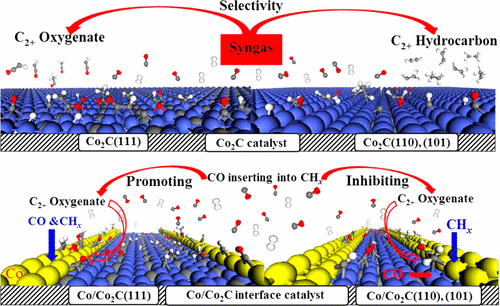当前位置:
X-MOL 学术
›
ACS Catal.
›
论文详情
Our official English website, www.x-mol.net, welcomes your
feedback! (Note: you will need to create a separate account there.)
C2 Oxygenate Synthesis via Fischer–Tropsch Synthesis on Co2C and Co/Co2C Interface Catalysts: How To Control the Catalyst Crystal Facet for Optimal Selectivity
ACS Catalysis ( IF 11.3 ) Pub Date : 2017-11-07 00:00:00 , DOI: 10.1021/acscatal.7b02800 Riguang Zhang 1, 2 , Guangxiang Wen 1 , Hertanto Adidharma 2 , Armistead G. Russell 3 , Baojun Wang 1 , Maciej Radosz 2 , Maohong Fan 2, 3, 4
ACS Catalysis ( IF 11.3 ) Pub Date : 2017-11-07 00:00:00 , DOI: 10.1021/acscatal.7b02800 Riguang Zhang 1, 2 , Guangxiang Wen 1 , Hertanto Adidharma 2 , Armistead G. Russell 3 , Baojun Wang 1 , Maciej Radosz 2 , Maohong Fan 2, 3, 4
Affiliation

|
Density functional theory (DFT) analysis is used to shed light on the intricate effects of the Co2C and Co/Co2C catalyst crystal facets on the selectivity of the C2 oxygenate and hydrocarbon formation in Fischer–Tropsch synthesis. Three representative low-index Co2C (101), (110), and (111) surfaces, varying in surface energy from low and medium to high, are model examples of different Co2C exposed crystal facets. Since CHx (x = 1–3), CO, and H species are the key intermediates critical to the C2 oxygenate selectivity, all Fischer–Tropsch reactions related to CHx (x = 1–3) species, including CO insertion into CHx (x = 1–3) and CHx + CHy (x, y = 1–3) coupling to form C2 species (C2Hx and C2HxO), as well as the hydrogenation and dissociation of CHx (x = 1–3) to form C1 species (CH4 and C), are used as examples examined at a typical FTS temperature of 493 K. On Co2C (101) and (110) surfaces, CH and CH2 species are dominant form of the CHx species, CH self-coupling to C2H2 and CH coupling with CH2 to CH2CH is dominant C2 species. However, on a Co2C (111) surface, only CH monomer is a dominant CHx (x = 1–3) species, and CO insertion into CH to form CHCO is a dominant C2 species. CH4 and C production on these three surfaces is impossible. These results show that C2 species formation, rather than C1 species, is a preferable pathway on different Co2C crystal facets in FTS reactions. Moreover, the C2 selectivity, quantitatively estimated from the effective barrier difference, is found to be sensitive to the Co2C crystal facet. The Co/Co2C (111) interface catalyst is more favorable for C2 oxygenate formation in comparison to the pure Co2C (111) catalyst, whereas the Co/Co2C (110) and Co/Co2C (101) interface catalysts are unfavorable for C2 oxygenate formation in comparison to the pure Co2C (110) and (101) catalysts. Therefore, for the FTS over Co2C and Co/Co2C catalysts, the Co2C (111) crystal facet is found to have an unexpectedly high selectivity for C2 oxygenates, whereas the Co2C (101) and (110) crystal facets are found to have a high selectivity toward C2 hydrocarbons. The results mean that controlling the crystal facets of Co2C catalysts using well-defined preparation methods can be an effective tool to tune the FTS selectivity toward the most desirable products.
中文翻译:

Co 2 C和Co / Co 2 C界面催化剂上费托合成的C 2含氧化合物的合成:如何控制催化剂晶面以获得最佳选择性
密度泛函理论(DFT)分析用于阐明费托合成中Co 2 C和Co / Co 2 C催化剂晶面对C 2含氧化合物的选择性和碳氢化合物形成的复杂影响。三个代表性的低折射率Co 2 C(101),(110)和(111)表面的表面能从低,中到高变化,是不同的Co 2 C暴露晶体面的模型示例。由于CH x(x = 1-3),CO和H物种是对C 2含氧化合物选择性至关重要的关键中间体,因此所有费托反应都与CH x(x= 1-3)种,包括将CO插入CH x(x = 1-3)和CH x + CH y(x,y = 1-3)耦合形成C 2物种(C 2 H x和C 2 H x O)以及CH x的氢化和解离(x = 1-3)形成C 1物种(CH 4和C),被用作在493 K的典型FTS温度下检测的实例。关于Co 2在C(101)和(110)表面上,CH和CH 2是CH x的主要形式CH 2与CH 2 H 2的自偶联以及CH 2与CH 2 CH 2的CH偶联是主要的C 2种类。但是,在Co 2 C(111)表面上,只有CH单体是占主导地位的CH x(x = 1-3)物种,CO插入CH形成CHCO的过程是占优势的C 2物种。在这三个表面上无法生成CH 4和C。这些结果表明,在FTS反应中,在不同Co 2 C晶面上形成C 2物种而不是C 1物种是优选的途径。而且,C 2从有效势垒差定量估计的选择性对Co 2 C晶体晶面敏感。与纯Co 2 C(111)催化剂相比,Co / Co 2 C(111)界面催化剂更有利于C 2含氧化合物的形成,而Co / Co 2 C(110)和Co / Co 2 C(101与纯Co 2 C(110)和(101)催化剂相比,界面催化剂对C 2含氧化合物的形成不利。因此,对于采用Co 2 C和Co / Co 2 C催化剂的FTS ,Co 2发现C(111)晶面对C 2含氧化合物具有出乎意料的高选择性,而发现Co 2 C(101)和(110)晶面对C 2烃具有高选择性。结果表明,使用定义明确的制备方法控制Co 2 C催化剂的晶面可能是将FTS选择性调整为最理想产品的有效工具。
更新日期:2017-11-08
中文翻译:

Co 2 C和Co / Co 2 C界面催化剂上费托合成的C 2含氧化合物的合成:如何控制催化剂晶面以获得最佳选择性
密度泛函理论(DFT)分析用于阐明费托合成中Co 2 C和Co / Co 2 C催化剂晶面对C 2含氧化合物的选择性和碳氢化合物形成的复杂影响。三个代表性的低折射率Co 2 C(101),(110)和(111)表面的表面能从低,中到高变化,是不同的Co 2 C暴露晶体面的模型示例。由于CH x(x = 1-3),CO和H物种是对C 2含氧化合物选择性至关重要的关键中间体,因此所有费托反应都与CH x(x= 1-3)种,包括将CO插入CH x(x = 1-3)和CH x + CH y(x,y = 1-3)耦合形成C 2物种(C 2 H x和C 2 H x O)以及CH x的氢化和解离(x = 1-3)形成C 1物种(CH 4和C),被用作在493 K的典型FTS温度下检测的实例。关于Co 2在C(101)和(110)表面上,CH和CH 2是CH x的主要形式CH 2与CH 2 H 2的自偶联以及CH 2与CH 2 CH 2的CH偶联是主要的C 2种类。但是,在Co 2 C(111)表面上,只有CH单体是占主导地位的CH x(x = 1-3)物种,CO插入CH形成CHCO的过程是占优势的C 2物种。在这三个表面上无法生成CH 4和C。这些结果表明,在FTS反应中,在不同Co 2 C晶面上形成C 2物种而不是C 1物种是优选的途径。而且,C 2从有效势垒差定量估计的选择性对Co 2 C晶体晶面敏感。与纯Co 2 C(111)催化剂相比,Co / Co 2 C(111)界面催化剂更有利于C 2含氧化合物的形成,而Co / Co 2 C(110)和Co / Co 2 C(101与纯Co 2 C(110)和(101)催化剂相比,界面催化剂对C 2含氧化合物的形成不利。因此,对于采用Co 2 C和Co / Co 2 C催化剂的FTS ,Co 2发现C(111)晶面对C 2含氧化合物具有出乎意料的高选择性,而发现Co 2 C(101)和(110)晶面对C 2烃具有高选择性。结果表明,使用定义明确的制备方法控制Co 2 C催化剂的晶面可能是将FTS选择性调整为最理想产品的有效工具。











































 京公网安备 11010802027423号
京公网安备 11010802027423号